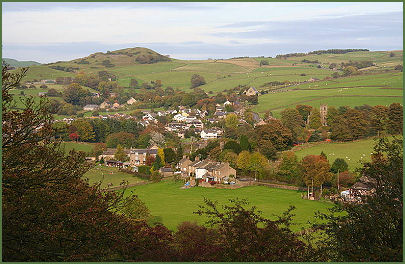Rainow
OS Grid ref:- SJ950761
 The village of Rainow lies in stunning scenery in the Cheshire Peak District and is situated 3 miles north-east of the town of Macclesfield.
The village of Rainow lies in stunning scenery in the Cheshire Peak District and is situated 3 miles north-east of the town of Macclesfield.
The village's name derives from the Anglo-Saxon Hraefn Hoe, meaning Ravens' Hill. In the middle ages medieval Rainow was a staging post on one of the salt routes on which packhorses carried salt eastwards from the mines of Cheshire.
The villages western boundary runs along the crest of Kerridge Hill, the name derives from Key Ridge from the Anglo-Saxon Caeg Hrycg, the hill now forms part of the Gristone Trail . While the heart of the village lies to the east of the river. Rainow is bounded to the north west by Bollington, to the north by the village of Pott Shrigley while to the south lies Macclesfield Forest.
The sandstone village chiurch of Holy Trinity was built in 1846, by John Mellor of Kerridge End. The architect was Samuel Howard of Disley.
Lamaload Reservoir is situated to the east of the village, the reservoir is fed by the River Dean and provides a supply of water to the nearby town of Macclesfield. The reservoir, which is is approximately 1,000ft (308m) above sea level, it is the highest constructed dam in England. The reservoir was built between 1958 and 1964. The surrounding landscape consists of moorland with plantations of larch and pine.
Ingersley Vale
 A footpath across the fields from the village of Rainow leads to Ingersley Vale, near Bollington. The vale is a deep and narrow valley which contains the now derelict Ingersley Clough Mill which was built in 1792, the mill, was rebuilt, follwing a fire, by Edward Collier in 1809. The mill began life producing cotton, but was later used as a calico print & bleaching works. The mill was damaged by fire again in 1999, since which time it has been the subject of a number of development proposals.
A footpath across the fields from the village of Rainow leads to Ingersley Vale, near Bollington. The vale is a deep and narrow valley which contains the now derelict Ingersley Clough Mill which was built in 1792, the mill, was rebuilt, follwing a fire, by Edward Collier in 1809. The mill began life producing cotton, but was later used as a calico print & bleaching works. The mill was damaged by fire again in 1999, since which time it has been the subject of a number of development proposals.
An impressive waterfall on the River Dean (pictured right) may be found at the lower end of Clough Pool, which once provided water to turn the water wheels at Ingersley Clough Mill. The water drove two separate water wheels, which were later replaced in the mid nineteenth century by a single huge wheel with a diameter which measured 56 feet, it was believed at the time to be the second largest water wheel in England and only surpasses in size by the the Laxey Wheel on the Isle of Man which had a diameter measuring 72 feet and 6 inches.
The water runs from the pool, down the waterfall and through a rocky gorge into the valley.
Ingersley House, now known as Savio House, a Grade II listed building, dates back to around 1775 and was built for for John Gaskell. The Gaskell family were responsible for erecting White Nancy, a well known landmark in Bollington visible for miles around. White Nancy was built in 1817 by John Gaskell junior to commemorate the victory of the Battle of Waterloo. Ingersley House is now used as a retreat and activities centre for young people.
A walk from Bollington, through Ingersley Vale and Rainow
Distance - 4 miles
*Walk down Church Street in Bollington until reaching the junction with Lord Street. Continue up Ingersley Vale, passing the derelict mill to reach the waterfall.
* From here follow along the paths which run south across the fields to reach Rainow. Continue along the road through the village until you arrive at the Robin Hood Inn.
*Continue along the lane behind the inn until arriving at a junction. Turn left and follow cobbled bridleway to the left.
*Follow the lane until reaching a road junction. Turn left down Smithy Brow and Ingersley Road to return to Bollington.
Nearby places of interest
Macclesfield Forest once the centre of a Royal Forest created by the Norman kings for the purpose of hunting game such as deer, wild boar and wolves. It once encompassed all the area from Disley to the River Dane. The forest is home to a herd of red deer, while the reservoirs contain a wide variety of wildfowl.
Adlington Hall Set in the heart of the Cheshire countryside, the current building was begun in 1315, although late medieval and Tudor remodeling have since changed its appearance. The Great Hall is a late fifteenth century addition, while a half timbered Tudor manor was added in the following century.
